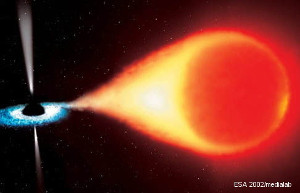Low mass X-ray binaries (LMXBs) are stellar systems consisting of two stars, one of which is a relativistic object - a neutron star or a black hole - and the other is a normal low-mass star, like our Sun, for example (Fig.1). If the separation between the two objects is comparable to the size of the normal star (which is hundreds thousands to millions of times larger than its relativistic companion), it may overfill it’s Roche lobe - the region of space where dynamics of matter are dominated by the gravitational attraction of the star. Consequently, it will start losing its outer layers under the gravitational pull of the second star. Material is predominantly lost through the so called inner Lagrangian point - the point on the line connecting the two stars where the forces of gravity and the centrifugal force balance each other out. The material of the donor star will flow through this point and will fall into the gravitation potential well of the relativistic star, initiating the process which is called accretion. Due to its large angular momentum, the infalling matter will form an accretion disk around the relativistic object (Fig.1). The classical theory of accretion disks around black holes and neutron stars was developed by Nikolai Shakura and Rashid Sunyaev in 1972. Due to the small size of the relativistic object (~15 km for a neutron star) the gravitational energy released during accretion constitutes a significant fraction of the rest mass energy of the accreting material, typically about 5-20%. This makes these systems very luminous sources of X-ray emission.

An artist’s impression of an accreting Low Mass X-ray Binary. The donor star fills its Roche lobe and its material overflows the inner Lagrangian points and accretes on the relativistic star (in this case a black hole). Due to the large angular momentum of the infalling material an accretion disk is formed around the compact object. For a little more insight into the project see this:http://www.mpa-garching.mpg.de/mpa/research/current_research/hl2014-8/hl2014-8-en.html
|
